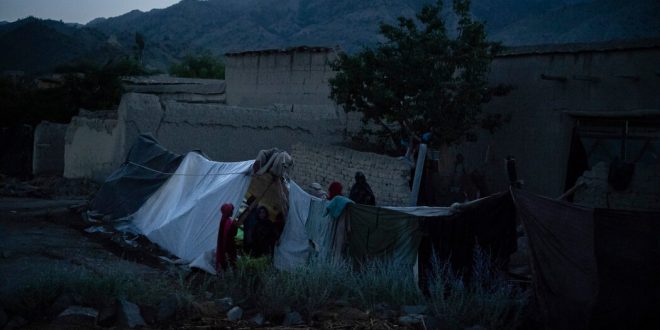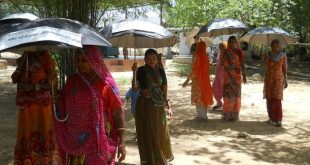Relief efforts ramped up on Friday to aid victims of the deadly earthquake that struck an impoverished region of southeastern Afghanistan this week in a disaster that killed hundreds and devastated a country already teetering on economic collapse nearly a year after the Taliban seized power.
As hopes of finding survivors faded, a second earthquake on Friday jolted Geyan, the district hit hardest by the 5.9-magnitude temblor on Wednesday. The follow-up quake killed at least five more people and injured another 11, according to local officials.
That added to the hundreds killed and many others injured on Wednesday in the provinces of Paktika and Khost, which are both on the border with Pakistan. According to Zabihullah Mujahid, a spokesman for the Taliban, more than 1,000 people died and at least 3,000 others were injured; the United Nations Office for the Coordination of Humanitarian Affairs on Wednesday put the current death toll at 770.
Large numbers of people are missing, and aid agencies have said that they expect the toll in the rugged region, where communications and access are difficult, to rise.
The news of fresh tremors came as rescue efforts from Wednesday’s quake were winding down and as Taliban officials issued more calls for assistance from aid agencies and international governments. The Taliban and local functionaries said that they did not expect to find more survivors.
The punishing terrain and challenging weather conditions in the affected region made it difficult to send aid swiftly to Paktika Province, according to Mohammad Nasim Haqqani, a spokesman for the Afghan Ministry of Disaster Management.
But as of Friday morning, a flow of aid from international governments and agencies had begun to stream in via air and road. Volunteers were carrying in whatever aid and supplies they could in their cars in a makeshift convoy along unpaved and steep mountain roads.
About 42 humanitarian aid planes and group of 15 trucks sent by the Ministry of Disaster Management carrying emergency housing and food items — including rice, oil and flour — had reached the province and the supplies were already being distributed, according to Mr. Haqqani, who said that the Afghan government had allocated 100 million afghani, or about $1.1 million, to help survivors.
Planes filled with medical supplies and aid from India, Iran and the United Arab Emirates began arriving early Friday, according to Mr. Mujahid, the Taliban spokesman.
“The aid that has been given to the people is enough for 10 to 15 days, but they have lost everything and there is a constant need for cooperation from international aid agencies,” Mr. Mujahid said. Afghans based abroad, he added, were having trouble making donations as the Afghan banking system has largely collapsed under the weight of international sanctions.
The Taliban said on Thursday that some supplies had also arrived from Pakistan and Qatar. The United States, along with the United Nations and the World Health Organization, also took steps to provide aid. South Korea has promised $1 million in humanitarian assistance.
Across Afghanistan, an army of volunteers, including teachers, students, and young professionals, fanned out to raise funds and collect supplies. Najib Alkozai, 34, a journalist in Nangarhar Province who lost his job at a local television station after the Taliban takeover last year, said that he had been working with a team in the city of Jalalabad to collect donations.
“Today people donated more than 500,000 Afghanis,” or the equivalent of about 5,600 dollars, Mr. Alkozai said, adding that donations had come from people from all walks of life, including “day laborers, construction workers, farmers, teachers.”
While the earthquake was considered moderate in magnitude, it wreaked havoc in southeastern Afghanistan, where many houses are made of masonry or even mud and were unable to withstand the force of the tremors. More than 2,100 homes were estimated to have been damaged in Khost and Paktika, according to the World Food Program, with the worst damage centered in Paktika.
In Geyan alone, one of the districts in the province that was pummeled by the quake, the World Food Program said that 1,500 houses had been damaged or destroyed. The Afghan disaster management ministry said that the damage was even more extensive, estimating that more than 10,000 houses had been affected.
The disaster could hardly have come at a worse time for Afghanistan, a nation of 39 million that has been in the throes of economic collapse since the Taliban stormed to power in August and toppled a government that had been sustained for two decades by support from Western governments and a military coalition led by the United States.
Before the Taliban took over, foreign aid funded 75 percent of the Afghan government’s budget. The Taliban has since struggled to attract foreign money as Western donors have balked at edicts barring girls from attending school and restricting women’s rights, among other concerns.
Some of the challenges, such as a drought and hunger, have been shaped by external factors. But others, including the flight of refugees and an exodus of skilled workers, stem from fears about how the Taliban, a group that ran a harsh regime of repression the previous time it was in power, will govern this time round.
In that context, the earthquake presented a major test of the Taliban’s rule.
While some trained ministry officials stayed in their roles after the Taliban took power, most left, limiting the experience pool that the government can draw on to help coordinate relief efforts.
The disaster was also a test for the Biden administration’s approach to the Taliban; the United States currently refuses to recognize or provide the group with financial assistance.
American aid to Afghanistan has continued, with more than $1 billion sent directly to humanitarian programs in the country over the past year. But many rights advocates say that Washington must work with the Taliban government and provide it with economic assistance to alleviate the widespread suffering on a lasting basis.
Taliban officials are also calling on Western nations to provide their country with more aid in the wake of the disaster. On Thursday, a senior official from the disaster management ministry, Ghulam Ghous Naseri, urged donor countries to “not politicize” their help and to “continue their aid to the people of Afghanistan,” according to Tolo News, an agency based in Kabul, the capital.
So far, the Biden administration has rejected entreaties to directly fund the Afghan government, insisting that the Taliban meet its earlier vows to allow women to attend school and go to work and follow though on a promise to deny sanctuary to terrorist groups. U.S. officials express fear that the Taliban might steal or redirect American aid for unintended uses.
In statements on Wednesday, senior Biden administration officials signaled that they were open to discussing humanitarian earthquake relief with the Taliban government.
The State Department’s spokesman, Ned Price, said that Washington had not received a direct request for assistance. But he added that he expected aid “will be a topic of conversation between U.S. officials and Taliban officials in the coming days.”
Jake Sullivan, the national security adviser, said in a statement that President Biden had directed the federal government to “assess U.S. response options.”
 Top Naija News – Nigeria News, Nigerian News & Top Stories Top Naija News – Nigerian Newspapers, Nigerian News. topnaijanews is a daily Nigerian newspaper covering Latest News, Breaking News, Entertainment, Sports, Lifestyle and Politics.
Top Naija News – Nigeria News, Nigerian News & Top Stories Top Naija News – Nigerian Newspapers, Nigerian News. topnaijanews is a daily Nigerian newspaper covering Latest News, Breaking News, Entertainment, Sports, Lifestyle and Politics.




